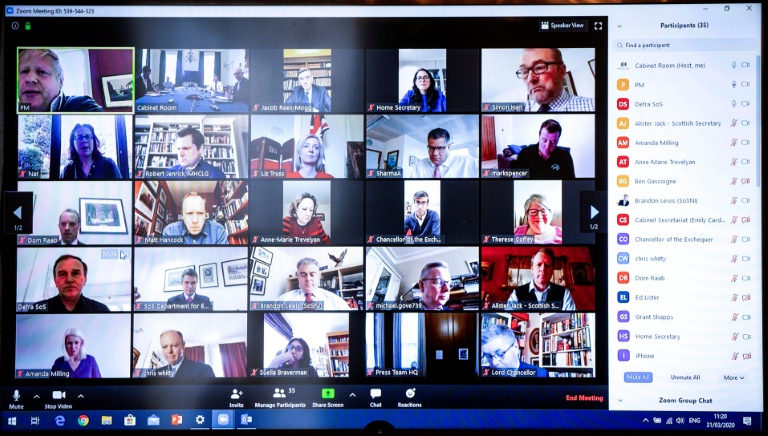
What does British Prime Minister Boris Johnson have in common with virtual happy hour celebrants and thousands of students around the world?
All use the Zoom videoconferencing application to get together while staying apart during the deadly coronavirus pandemic.
But amid its newfound fame, the Silicon Valley-based company has come under stepped-up scrutiny over how it handles privacy and security — including allowing uninvited guests to barge in on sessions.
Created by engineer Eric Yuan in 2011 and listed on the Nasdaq a year ago, Zoom has seen its market value skyrocket to some $35 billion.
Yuan has spoken of a passion for communication technologies that dates back to the 1990s when, as a university student in mainland China, he longed for a way to see his girlfriend without needing to travel hours by train.
Zoom hit the market as a tool for people working apart to collaborate on business, competing with offerings from the likes of Microsoft, Facebook, Google and others.
– Poker and funerals –
As people around the world stay home due to coronavirus risk, Zoom has become a go-to service for remote education, exercise classes, poker games, church services and happy hour celebrations.
Couples have gotten married in “zoomed” ceremonies. Birthdays have been celebrated. Funerals have been virtually attended.
“It’s really easy to use, and free; that’s nice,” said US school teacher Justin Minkel, who instructs students remotely using Zoom. “Just click a link.”
Home chaos such as dogs barking or outbursts from siblings can be disruptive, but Minkel cures that by “muting” students’ microphones until he needs to hear them.
According to Yuan, the number of people taking part in Zoom meetings daily eclipsed 200 million in March, up from just 10 million at the end of last year.
Video calls have surged on all messaging platforms including WhatsApp, Messenger, and Google Hangouts, but Zoom has become a star.
It lets as many as 100 people simultaneously attend a video-conference, allowing 40 minutes free and then charging for premium accounts that provide more time and features for $15 monthly.
Zoom lifted the 40-minute limit on free accounts for teachers in an array of countries.
Among Zoom settings is an option to chose a backdrop image, such as the Golden Gate Bridge or tropical beach, hiding what is really behind a user.
– Zoombombing –
Digital learning coach Stephanie DeMichele credits the surge in Zoom use to fear of being disconnected from schools, friends, families and others in our lives.
“And here comes Zoom saying ‘It’s free, available, and you won’t feel isolated,'” said DeMichele. “So people grabbed onto it.”
A “Zoombombing” phenomenon has sparked warnings about lax security, however.
Virtual intruders have interrupted religious ceremonies, remote classes, and other Zoom gatherings. In some cases, pornographic images have been displayed.
US media has reported that Zoom shares some data with third parties and questioned how well virtual meeting data is defended.
Prosecutors from several US states including Connecticut, New York, and Florida are investigating the company’s privacy and security practices. The FBI has warned of Zoom sessions being hijacked.
Yuan vowed this week to step up data security, and apologized.
“We recognize that we have fallen short of the community’s — and our own — privacy and security expectations,” Yuan said in a message posted online.
“For that, I am deeply sorry.”
Zoom was designed primarily for use by large businesses with their own tech teams to provide support and protection, according to Yuan.
“We did not design the product with the foresight that, in a matter of weeks, every person in the world would suddenly be working, studying, and socializing from home,” Yuan said.
“These new, mostly consumer use cases have helped us uncover unforeseen issues with our platform.”
While encouraged that Zoom is admitting it has security problems, it still has “a ton of work” to do to fix them and restore trust in the platform, according to Electronic Frontier Foundation associate director of research Gennie Gebhart.
While tending to its immediate concerns, Zoom would be wise to keep on eye on the future, said Creative Strategies analyst Carolina Milanesi.
“Replicating what Zoom has is not too difficult,” Milanesi said.
“They need to think about what else they want to be.”
Image: 10 Downing Street/AFP/File / Pippa FOWLES Prime Minister Boris Johnson (top left) holds a cabinet meeting via Zoom on March 31




